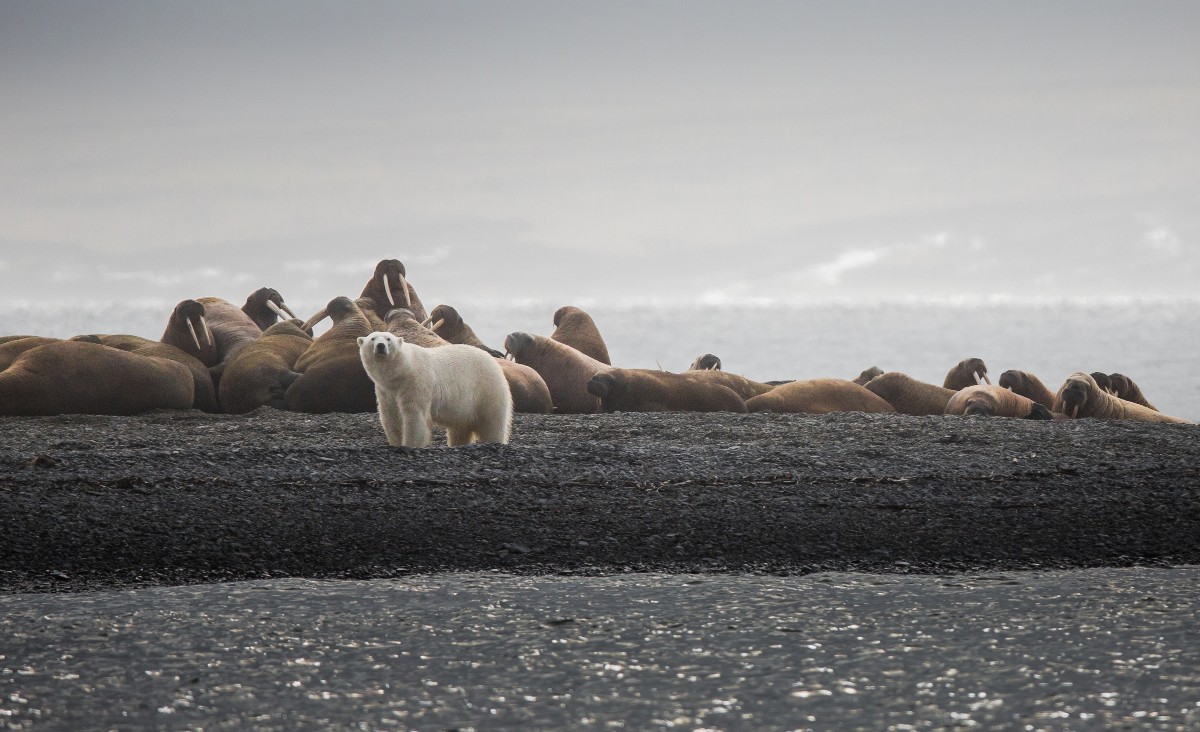© Anatoly Kochnev
Features
Our Planet: The story behind the walruses
- Canada
- Climate Change
- Greenland
- Norway
- Oil and gas
- Pan-Arctic
- Russia
- Shipping
- The Last Ice Area
Walruses are incredible.
On land, they’re hulking, belching, flatulent 1 tonne beasts. They have a substantial layer of blubber covered by thick skin (up to 4cm which is amongst the thickest skin in the world – human skin is only around 1.3mm thick) and coarse hair. But most impressive are their long tusks and stiff bristles around their mouths. Walruses certainly make a statement.
They can live to around 40 years old, and it shows. Most of them carry a vast map of scars on their skin – wounds inflicted by fellow walrus when they gather in tightly packed “haulouts” (pronounced hall out). They let their neighbours feel their displeasure with a sharp puncture from a tusk. Walruses also use their incredible tusks for fighting, to form breathing holes and to haul their huge bodies onto the sea ice.
Underwater, they’re almost majestic. They make many strange underwater sounds – one of them is like a deep-pitched church bell. They’re rarely found in the deep, instead preferring to feed at the bottom of shallow waters around coastlines, mostly eating molluscs.
There are two subspecies of walrus – the Atlantic and Pacific – which both occupy different areas of the Arctic. But for both walruses, their world is changing fast.
© Staffan Widstrand / WWF
Deadly crowds
Pacific walruses, like the ones in the Our Planet series, spend spring and summer feeding over the huge, shallow continental shelf. They use the sea ice as a platform for resting, and where mothers leave their young calves, between dives.
In the past decade, earlier melting of sea ice in summer has meant the ice has receded hundreds of kilometres north of the shelf, forcing abnormally large numbers of Pacific walruses – tens of thousands – ashore.
These mass gatherings are deadly. Stampedes occur as easily spooked walruses trample one another in their attempt to reach the water. Many walruses, particularly young calves, die. Those that do survive must travel exhausting distances to find food, as nearby sources are quickly depleted.
Watch: A walrus stampede
© Rob Oo / Flickr / CC BY
Climate changes
Human disturbance
Unlike Pacific walruses, Atlantic walruses prefer to rest ashore, as most feeding grounds in the Atlantic are closer to land. This means they’re highly susceptible to disturbance and noise – from tourists, low-level aircraft and passing ships. This human-made noise is only set to worsen as the Arctic becomes more accessible with diminishing sea ice.
Opportunities for shipping routes, commercial fishing and infrastructure such as housing and harbours are opening up across the Arctic. These activities cause a huge amount of noise and break-up sea ice, whilst fishing can result in the accidental capture of walrus in nets and bottom trawlers destroying feeding grounds.
Oil and gas developers are also looking northwards, meaning walruses could face the risk of toxic oil spills – virtually impossible to clean up on ice.
Changing predators

On land, polar bears are also attracted to large haulouts – and the smell of carcasses. They not only disturb walruses but can endanger people in nearby communities. © Alexei Ebel / WWF-Canon

Killer whales, with their tall dorsal fins, aren’t designed for swimming in thick sea ice. But melting ice means these predators have a whole new feeding ground to hunt in. And they hunt walrus. © Kevin Schafer / WWF
What WWF is doing for walruses
Research
We support research into walrus populations and feeding areas. Our findings enable us to make recommendations to better safeguard them.
Safety
In Russia where the biggest haulouts occur on land, we’re working with nearby communities to keep people safe, by removing dead walruses and scaring any polar bears away.
Better tourism
We’re working with tourist operators and shipping companies to reduce the risks to walruses, as well as researching walrus behaviour at haulouts and the effects shipping has on them.
Safer shipping
In Canada, we’ve produced a guide for mariners on the Hudson Strait to help them identify and report on walruses and their habitat, and teach them what to do during any encounters.
By WWF Global Arctic Programme